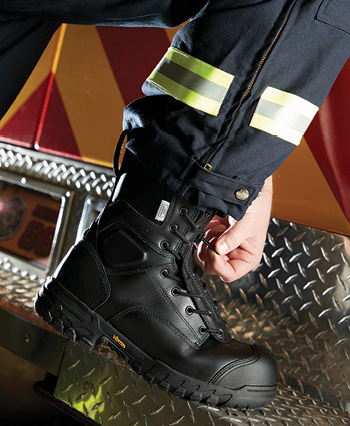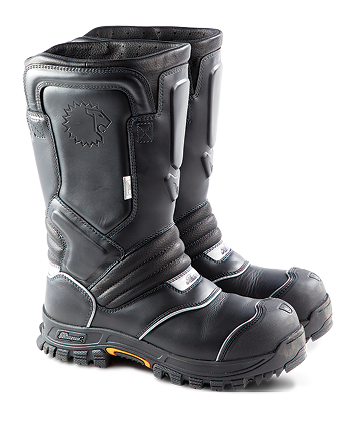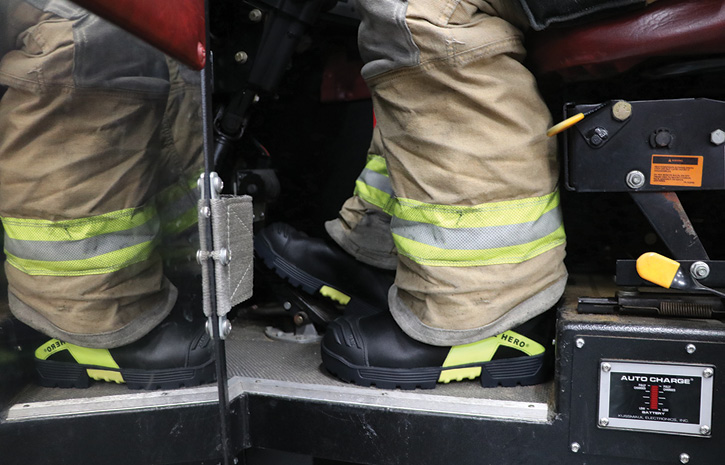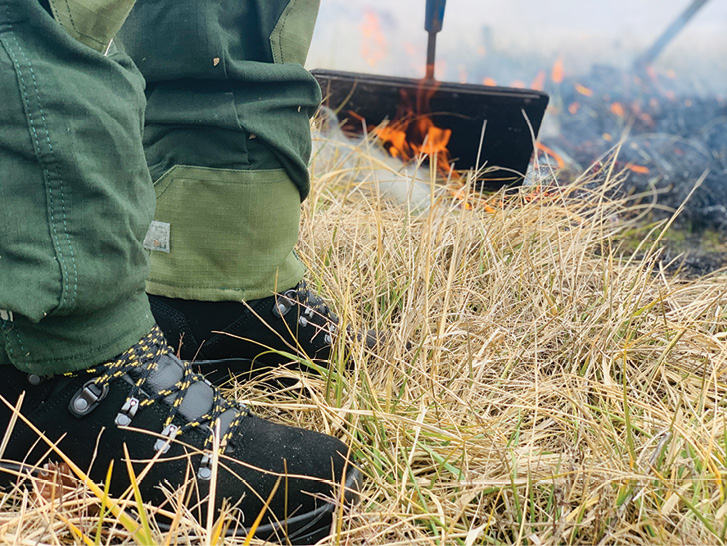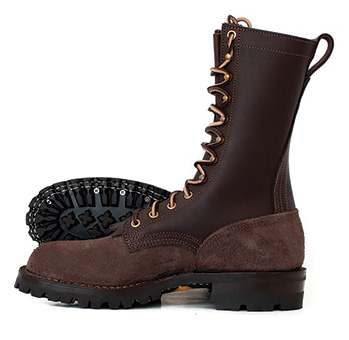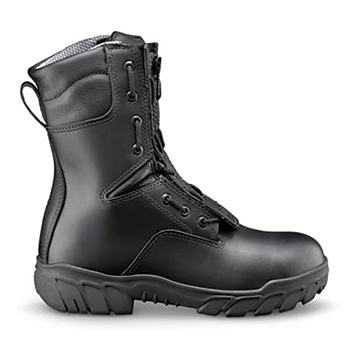Structural firefighting boots and wildland fire boots may both be constructed of leather these days, but the similarities don’t end there. Both types of fire boots have the chief aim of protecting the firefighter from hazards but also to be as comfortable and ergonomic as possible, especially during long wearing periods.
Bob Theriot, director of the fire division for Thorogood Shoes, says Thorogood is in a partnership with Lion to provide firefighters with both structural and wildland fire boots. “Thorogood designs and manufactures the boots, and Lion markets and sells them,” Theriot observes. “In November of 2019, we rolled out the QR14™ leather structural firefighting boot, which feedback has shown is very comfortable and moves very well with the firefighter and not against him. It’s designed after a motocross-style boot with flex points at the arch and above the heel so the upper flexes. Firefighters spend a lot of time on their knees or in a squat, so flexibility is important.”
Theriot notes that both the QR14 and Thorogood’s Knockdown Elite™ leather structural firefighting boots are compliant with National Fire Protection Association (NFPA) 1971, Standard on Protective Ensembles for Structural Fire Fighting and Proximity Fire Fighting, and use a cement construction for the outsole. “We use a Vibram ATF high-carbon, rubber outsole with an all-traction surface on the Knockdown Elite,” he says, “while the QR14 has a cemented proprietary outsole.”
1 Thorogood Shoes and Lion make a Wildland EMS boot in a hiker design that’s lighter and more flexible with a cemented outsole. (Photo 1 courtesy of Lion.)
2 Thorogood and Lion make the QR14™ leather structural firefighting boot, designed with flex points at the arch and above the heel so the upper flexes. (Photo 2 courtesy of Thorogood Shoes.)
Thorogood also makes a Wildland EMS boot that is compliant with NFPA 1977, Standard for Protective Clothing and Equipment for Wildland Firefighting, and NFPA 1999, Standard on Protective Clothing and Ensembles for Emergency Medical Operations, according to Theriot. “We redesigned our Wildland EMS boot from a welted product to one with a cemented outsole,” he says. “We made the boot lighter and more flexible, with a hiker-style design that has a lower heel than the pronounced heel of the logger-style wildland firefighting boot.”
Josef Teibl, director of sales for HAIX North America Inc., says HAIX makes four styles of structural firefighting boots compliant with NFPA 1971; a structural/urban search and rescue (USAR) boot compliant with NFPA 1971, 1977, NFPA 1951, Standard on Protective Ensembles for Technical Rescue Incidents, and NFPA 1992, Standard on Liquid Splash-Protective Ensembles and Clothing for Hazardous Materials Emergencies; and one wildland firefighting boot, compliant with NFPA 1977.
3 HAIX makes the Fire Hero Extreme structural firefighting boot using full hide bull leather for extra protection so the boot retains its natural shape. (Photos 3-4 courtesy of HAIX.)
4 HAIX’s Missoula 2.1 wildland firefighting boot is a lace-up hiking style model with rough side out leather that has sun reflect qualities because of pigments processed into the leather.
HAIX’s Fire Hero Extreme, Fire Hunter Extreme, Fire Eagle Air, and Fire Hunter USA structural boots and its USAR boot all use full hide bull leather, Teibl points out, “which helps the boot retain its original shape and provides extra protection because the hide is thicker. The leather on our structural boots is smooth hide out, and all those versions have a climate system of vent holes at the top of the shaft.” Teibl adds that HAIX’s most popular models are the Fire Eagle and the Fire Hero.
HAIX’s Fire Flash Extreme boot is a lace-up model that’s compliant with four NFPA standards and has a CROSSTECH™ liner and insoles, a HAIX Micro-Soft Light sole, and a ladder shank for extra support on ladder rungs, Teibl notes. HAIX’s Missoula 2.1 wildland boot is a lace-up hiking-style wildland firefighting boot, Teibl says, with rough out hide leather that can soak up water and give a cooling effect and that also has sun reflective qualities because of pigments processed into the leather. “It’s designed for firefighters who have to walk long distances and carry heavy loads,” Teibl says, “and has a cemented fire resistant (FR) sole that does not melt.”
Derrick Mitsch, product line manager for turnout gear and boots at MSA Safety, says MSA/Globe makes three leather structural firefighting boot models, the Supraflex™ 14-inch, the Supralite® 14-inch, and the Supreme™ 14-inch, all three compliant with NFPA 1971 and 1992.
5 Black Diamond Group makes the X2 leather structural firefighting boot with an athletic heel fit and elastic band around the calf in the rear to allow more flexibility. (Photo 5 courtesy of Black Diamond Group.)
6 Nick’s Handmade Boots makes a 10-inch-high wildland firefighting boot with a classic arch and logger-style heel. (Photos 6-7 courtesy of Nick’s Handmade Boots.)
7 Nick’s makes a wildland firefighting boot with the same design as the logger style but with a moderate arch and lower heel, much like a hiking boot, that’s often used in flatter territory.
8 MSA/Globe makes the Supraflex™ 14 leather structural firefighting boot with continuous segmented flex panels to make the boots feel like athletic shoes. (Photos 8-9 courtesy of MSA/Globe.)
9 MSA/Globe makes three models of leather wildland firefighting boot that are compliant with the NFPA wildland standard.
The Supraflex is made with continuous segmented flex panels to make the boots feel like athletic shoes, Mitsch points out. The boots have recessed pull-on handles inset on the sides and flexible NOMEX® webbing carry loops. The boot is compliant with NFPA 1971 and 1992. The Supralite boot is also compliant with those two standards and has a lighter and more flexible design, using a DRAGONHIDE® covering and a PREDATOR™ outsole. The Supreme is designed as flexible athletic footwear with a combination cushioned and contoured sole and an internal fit system that makes the boot fit like a pair of sneakers, Mitsch points out. Supreme has a specially designed and formulated outsole for the best grip on wet, dry, or icy surfaces, he says.
MSA/Globe also has three boot models compliant with NFPA’s wildland standard, Mitsch adds: one to NFPA 1977, a second model for dual use compliant with NFPA 1977 and 1999, and the third a wildland station boot.
Stephanie Hoth, national sales director for Black Diamond Group, says Black Diamond’s X2 leather structural firefighting boot is 14 inches high and comes with an insole that has two layers underneath, which are removable to make the boot into either a wide or extra wide model. The X2 is compliant with NFPA 1971, 1999, and 1992, Hoth points out. “The X2 has an athletic heel fit and an elastic band around the calf in the rear to allow more flexibility for the firefighter and integrated pull-on straps that are reinforced and part of the upper,” she notes.
Nathan Kromer, marketing director for Nick’s Handmade Boots, says his company has been making firefighting boots for wildland and structural use since the 1960s. “We started with the classic arch and logger heel style wildland boot that’s 10 inches high and compliant to NFPA 1977 and are still making that model in a number of different versions,” Kromer points out. “About 20 years ago, we introduced a wildland model boot of pretty much the same design as the logger style but with a moderate arch and lower heel, more like a hiking boot, that’s great for flatter territory.”
Kromer says Nick’s Handmade Boots all have a fully gusseted tongue that makes them water resistant to the 10-inch-high point and are available in either rough side out or smooth side out leather in four colors.
ALAN M. PETRILLO is a Tucson, Arizona-based journalist, the author of three novels and five nonfiction books, and a member of the Fire Apparatus & Emergency Equipment Editorial Advisory Board. He served 22 years with the Verdoy (NY) Fire Department, including in the position of chief.
